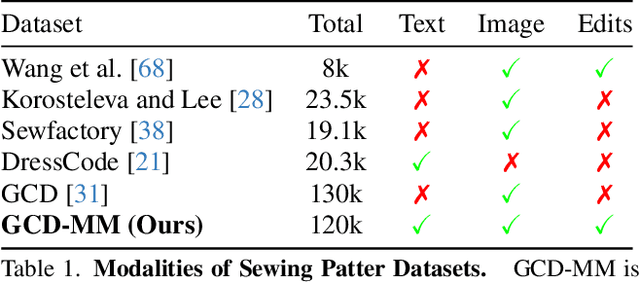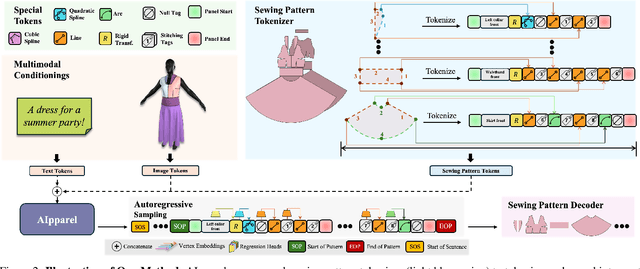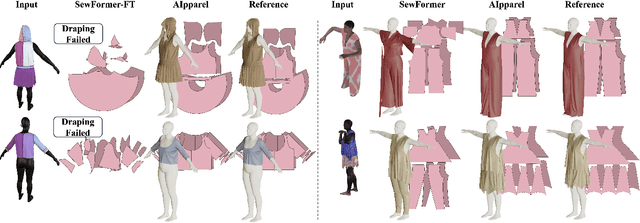Kiyohiro Nakayama
AIpparel: A Large Multimodal Generative Model for Digital Garments
Dec 05, 2024



Abstract:Apparel is essential to human life, offering protection, mirroring cultural identities, and showcasing personal style. Yet, the creation of garments remains a time-consuming process, largely due to the manual work involved in designing them. To simplify this process, we introduce AIpparel, a large multimodal model for generating and editing sewing patterns. Our model fine-tunes state-of-the-art large multimodal models (LMMs) on a custom-curated large-scale dataset of over 120,000 unique garments, each with multimodal annotations including text, images, and sewing patterns. Additionally, we propose a novel tokenization scheme that concisely encodes these complex sewing patterns so that LLMs can learn to predict them efficiently. \methodname achieves state-of-the-art performance in single-modal tasks, including text-to-garment and image-to-garment prediction, and enables novel multimodal garment generation applications such as interactive garment editing. The project website is at georgenakayama.github.io/AIpparel/.
ProvNeRF: Modeling per Point Provenance in NeRFs as a Stochastic Process
Jan 18, 2024Abstract:Neural radiance fields (NeRFs) have gained popularity across various applications. However, they face challenges in the sparse view setting, lacking sufficient constraints from volume rendering. Reconstructing and understanding a 3D scene from sparse and unconstrained cameras is a long-standing problem in classical computer vision with diverse applications. While recent works have explored NeRFs in sparse, unconstrained view scenarios, their focus has been primarily on enhancing reconstruction and novel view synthesis. Our approach takes a broader perspective by posing the question: "from where has each point been seen?" -- which gates how well we can understand and reconstruct it. In other words, we aim to determine the origin or provenance of each 3D point and its associated information under sparse, unconstrained views. We introduce ProvNeRF, a model that enriches a traditional NeRF representation by incorporating per-point provenance, modeling likely source locations for each point. We achieve this by extending implicit maximum likelihood estimation (IMLE) for stochastic processes. Notably, our method is compatible with any pre-trained NeRF model and the associated training camera poses. We demonstrate that modeling per-point provenance offers several advantages, including uncertainty estimation, criteria-based view selection, and improved novel view synthesis, compared to state-of-the-art methods. Please visit our project page at https://provnerf.github.io
NeRF Revisited: Fixing Quadrature Instability in Volume Rendering
Oct 31, 2023



Abstract:Neural radiance fields (NeRF) rely on volume rendering to synthesize novel views. Volume rendering requires evaluating an integral along each ray, which is numerically approximated with a finite sum that corresponds to the exact integral along the ray under piecewise constant volume density. As a consequence, the rendered result is unstable w.r.t. the choice of samples along the ray, a phenomenon that we dub quadrature instability. We propose a mathematically principled solution by reformulating the sample-based rendering equation so that it corresponds to the exact integral under piecewise linear volume density. This simultaneously resolves multiple issues: conflicts between samples along different rays, imprecise hierarchical sampling, and non-differentiability of quantiles of ray termination distances w.r.t. model parameters. We demonstrate several benefits over the classical sample-based rendering equation, such as sharper textures, better geometric reconstruction, and stronger depth supervision. Our proposed formulation can be also be used as a drop-in replacement to the volume rendering equation of existing NeRF-based methods. Our project page can be found at pl-nerf.github.io.
DiffFacto: Controllable Part-Based 3D Point Cloud Generation with Cross Diffusion
May 04, 2023Abstract:While the community of 3D point cloud generation has witnessed a big growth in recent years, there still lacks an effective way to enable intuitive user control in the generation process, hence limiting the general utility of such methods. Since an intuitive way of decomposing a shape is through its parts, we propose to tackle the task of controllable part-based point cloud generation. We introduce DiffFacto, a novel probabilistic generative model that learns the distribution of shapes with part-level control. We propose a factorization that models independent part style and part configuration distributions and presents a novel cross-diffusion network that enables us to generate coherent and plausible shapes under our proposed factorization. Experiments show that our method is able to generate novel shapes with multiple axes of control. It achieves state-of-the-art part-level generation quality and generates plausible and coherent shapes while enabling various downstream editing applications such as shape interpolation, mixing, and transformation editing. Project website: https://difffacto.github.io/
 Add to Chrome
Add to Chrome Add to Firefox
Add to Firefox Add to Edge
Add to Edge